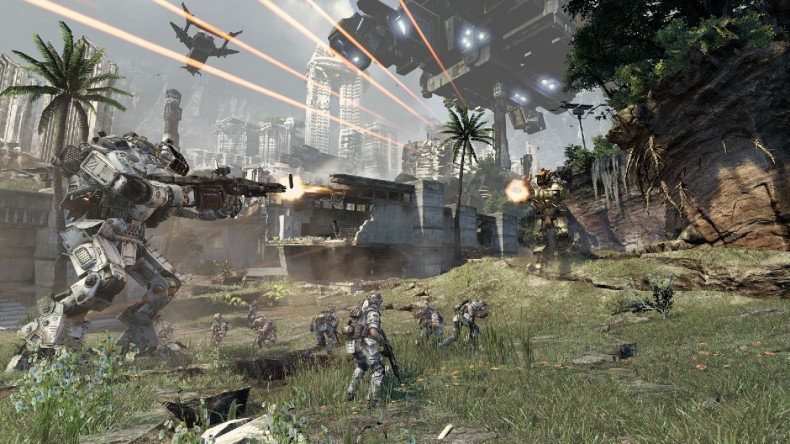Why is Titanfall Using Cloud Computing Again?

By far the most high profile console-exclusive heading our way in the first quarter of 2014, Titanfall is the game Microsoft is hedging its bets on when it arrives in March. The EA-published, Respawn Entertainment-developed FPS comes from the ashes of the years-long back and forth between Activision and Infinity Ward; dismissals, lawsuits, supposed unpaid royalties, alleged conspiracies… the whole debacle is well documented online. While the seemingly endless legal disputes would most certainly have been stressful and trying for former Infinity Ward heads Jason West and Vince Zampella at the time, it brought about the far less trying and stressful result of drumming up huge amounts of publicity for their newly formed studio and subsequently its partnership with EA and their as then unannounced project; the Internet was abuzz with wild speculation and hot anticipation before anyone even knew what Titanfall was or that it was even called Titanfall.
And in true Internet tradition, the levels of anticipation and hyperbole have reached fever pitch in the months since Titanfall‘s official unveiling. Not that you could exactly blame the media and masses of consumers for that; after all, how could a brand new IP from the people who, year on year, delivered games that routinely smashed sales records and have amassed an almost unprecedented level of popularity not get people excited? Plus it has mechs. And who doesn’t like mechs?
However, before they’ve even finished development and shipped the game, Respawn appears to have fallen victim to its own success. After promising epic, large scale battles and the melding of an online multiplayer-only environment with story-driven elements and NPC’s, they’ve experienced quite the sizeable backlash over the past week in response to the revelation that Titanfall‘s player-controlled headcount would be capped at a rather meager sounding 6v6. The initial kneejerk reaction to this nugget of information is understandable in itself. When one thinks of “epic and large scale” in regards to online multiplayer, twelve players doesn’t really wash. Battlefield 4 is parading about on Xbox One and PlayStation 4 with its impressive 64-player headcount, MAG: Massive Action Game on PlayStation 3 let up to 256 people go at it in huge, sprawling battlefields; Hell, I was even playing Unreal Championship on the Xbox with sixteen players on one map back in 2003 (ok, now I feel old).
So yeah, the Internet’s trademark policy of “bitch now, ask questions later” was somewhat warranted. But it’s only when you dig a little deeper into the issue that the low player count becomes truly bewildering. The thing is, Respawn sort of shot itself in the foot by going on about how Titanfall would utilise Microsoft’s much-touted cloud computing services to provide a smoother online experience replete with impressive visuals by offloading non-player activity to servers, thus the home console or computer would be left to solely concern itself with graphical performance. Personally, I can’t see why Respawn saw the need to utilise this technology, let alone advertise its use as a key selling point.
First off, Titanfall is, in my opinion, is a good looking game but it’s running in 720p and it’s hardly groundbreaking or jaw-dropping – there are more visually impressive Xbox One and PlayStation 4 launch titles – and it should also be noted that when doling out preview material of upcoming titles, developers have a tendency to touch up these screenshots – the equivalent of making Lady Gaga look less… male… in magazines and such – in an effort to drum up more interest by making the game seem graphically superior compared to how the finished product usually ships. Rarely will screenshots published months prior to a game’s commercial release be indicative of its true graphical quality.

Sure, Titanfall looks nice now, but then you’ll move in together and she’ll snore and use all your shaving gel on her legs.
Secondly, what’s the point in making use of cloud computing in order to insert things such as NPC’s and big plot-driven set-pieces into an online only multiplayer title – especially if it drastically lowers the max player count – when the vast majority of the people playing Titanfall won’t even appreciate their presence? Vince Zampella himself has even stated that the reason Titanfall lacks a true single player campaign is that hardly anyone ever actually played – let alone completed – the campaigns in their Call of Duty titles, saying:
We make these single-player missions that take up all the focus of the studio, that take a huge team six months to make, and players run through it in 8 minutes. And how many people finish the single-player game? It’s a small percentage. It’s like, everyone plays through the first level, but 5 percent of people finish the game. Really, you split the team. They’re two different games. They’re balanced differently, they’re scoped differently. But people spend hundreds of hours in the multiplayer experience versus ‘as little time as possible rushing to the end’ [in single-player]. So why do all the resources go there? To us it made sense to put it here. Now everybody sees all those resources, and multiplayer is better. For us it made sense.
So why neither Respawn, EA or Microsoft foresaw the backlash they’ve been bombarded with via Internet forums and the like is a mystery to me. Traditionally, people on the Internet will vocally and profusely air their concerns, opinions and vocabulary of profanities whether it’s appropriate or not. Granted, Titanfall is still nearly two months away from release and thus the potential for the game to astound us all with some unannounced miracles or technological epiphanies is definitely there. However, as it stands right now, Titanfall’s controversially low player count does make one wonder why its utilisation of cloud technology was even made publicly aware or touted in the manner that it was in the first place.













